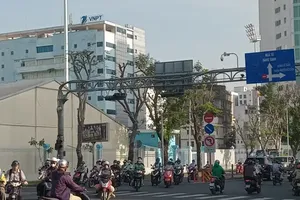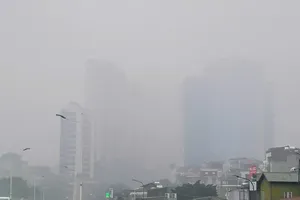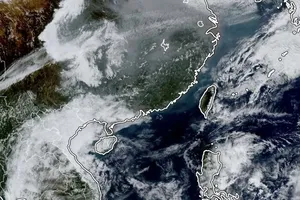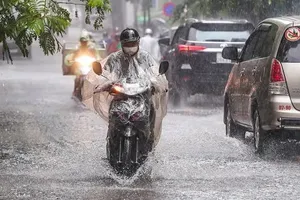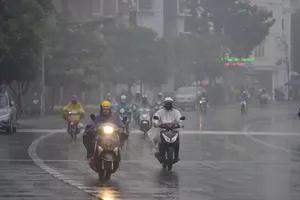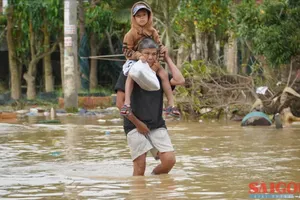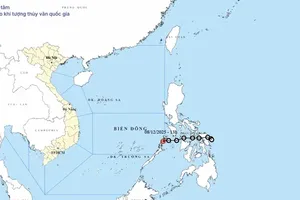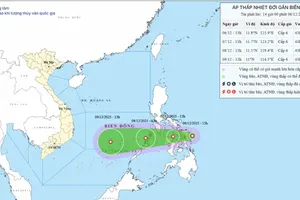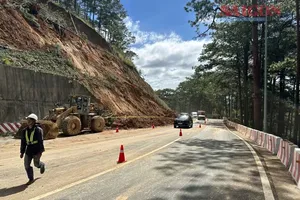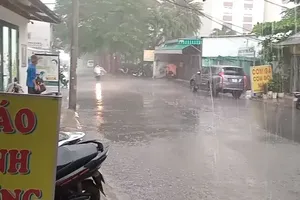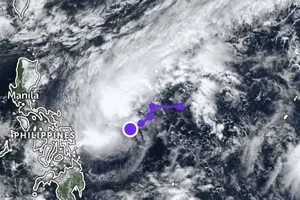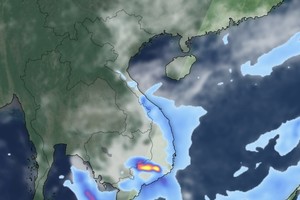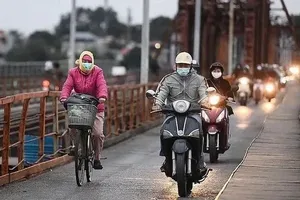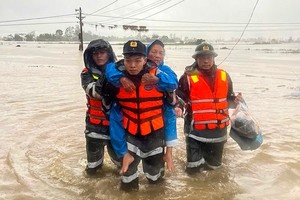
In response to these directives, Hoa Binh Hydropower Company opened the third bottom gate at 10 a.m. on August 5; Thac Ba Hydropower Joint Stock Company opened an additional surface gate at 2 p.m. on August 5. By the afternoon of August 5, four large hydropower reservoirs in the North were simultaneously releasing water. Specifically, Son La Hydropower Plant opened three bottom gates, Hoa Binh Hydropower Plant opened three bottom gates, Tuyen Quang Hydropower Plant opened three bottom gates, and Thac Ba Hydropower Plant opened three surface gates.
To ensure the safety of the structures and riverbank activities during the water release from these hydropower reservoirs, on the afternoon of August 5, the MARD issued a document requesting the People's Committees of the provinces and cities within the Red River basin, including Hanoi and Hai Phong cities, to immediately inform all-level authorities, residents, and organizations operating on and near the river to proactively take preventive measures to ensure the safety of people and property.
According to SGGP reporters on August 5, the Northwestern mountainous provinces in the upper reaches of the Red River continued to experience localized heavy rain, causing some residential areas to face flooding and landslides. In Lao Cai Province, the morning of August 5 saw sudden flooding on the Chay River (upstream of Thac Ba Hydropower Plant) in the section passing through Dien Quan and Thuong Ha communes of Bao Yen District, which caused flooding in many households in Trang Village, Dien Quan Commune.
Additionally, a 100-meter-long, 30-centimeter-wide crack appeared on the mountain range in Mo No.2 Village, Xuan Hoa Commune, Bao Yen District, from August 4 to 5. Mr. Hoang Van Nham, Vice Chairman of the People's Committee of Xuan Hoa Commune, stated that Bao Yen District's specialized agencies conducted an on-site inspection and urgently relocated four households at the foot of the mountain to a safe location.
On August 5, heavy rain occurred in Hoang Su Phi District, Ha Giang Province (near Bao Yen District in Lao Cai Province and Thac Ba Lake in Yen Bai Province). The Steering Committee for Natural Disaster Prevention and Search and Rescue of Hoang Su Phi District reported a landslide at around 5 a.m. on August 5 in Thong Nguyen Commune, resulting in the death of a 74 years old man of the Dao ethnic group and injuring two others in Giang Thuong Village. The road from Tan Quang District to Hoang Su Phi District was blocked by landslides, making it impassable for cars.
Additionally, in Ta Khoa Commune, Bac Yen District, Son La Province, another landslide on August 5 caused the death of a child born in 2024 and injured two others (the child's parents).
Before the 2024 storm season, a review revealed that Thanh Hoa Province had 1,286 damaged and degraded irrigation structures, including 86 reservoirs, 106 weirs, and 609 canals. The main reason for this is that these structures were built a long time ago, and maintenance and repair funding is limited.
On August 5, the Department of Agriculture and Rural Development of Bac Lieu Province reported that the Eastern Sea dyke section (in Vinh Trach Dong Commune, Bac Lieu City, adjacent to Soc Trang Province) had suffered severe erosion over the past few days, with a length of more than 100 meters.
The erosion was caused by the prior degradation of the protective forest along this section of the dyke, which allowed waves to hit directly and erode the dyke. According to forecasts, the erosion is expected to worsen in the near future due to rising tides combined with strong waves.
In response to the situation, Mr. Ngo Vu Thang, Vice Chairman of the Bac Lieu Provincial People's Committee, stated that he has directed relevant agencies to quickly assess the extent of the damage and urgently propose solutions for remediation. The Bac Lieu City People's Committee has been instructed to intensify inspections and monitoring of the dyke, closely follow developments, and promptly report any abnormal signs or high-risk erosion areas to devise timely countermeasures.
On the same day, the Department of Science and Technology of Hau Giang Province warned that prolonged heavy rain has caused strong, swirling flows in rivers, canals, and streams, increasing the risk of erosion. High-risk areas for erosion include Chau Thanh District, Nga Bay City, and Chau Thanh A District. These localities, situated along major rivers, are directly impacted by the flows during the rainy and flood season.
In Can Tho City, recent heavy rains have led to 24 instances of riverbank erosion, with a total length of 830 meters. This has resulted in over VND14.5 billion in damages. The erosion has completely destroyed 13 houses, caused subsidence in one warehouse, and partially affected or damaged 34 other houses. Local authorities are urgently coordinating with relevant agencies to implement immediate response measures and are also working on long-term projects to prevent floods, manage water levels, and address erosion.
On August 5, Mr. Nguyen Chien Thang, Chairman of Nam Phuong Tien Commune (Chuong My District), reported that as of the morning of the same day, four villages in the commune, with about 550 households, were still isolated by floodwaters, affecting 2,677 people, with Nhan Ly Village being the hardest hit.
In addition to following the "clean as the water recedes" principle, the commune is working with the Chuong My Irrigation Development Investment Enterprise to operate three out of four pumps at Nhan Ly drainage station to quickly remove water from residential areas and prepare for the resumption of agricultural activities. Authorities also continue to assess and provide essential supplies and distribute disease prevention medicine to residents still isolated by the flood.
Recently, floodwater from the Bui River in Chuong My District has receded. Many roads leading to the villages of Nam Hai, Nhan Ly, Hanh Bo, and Hanh Con (in Nam Phuong Tien Commune) are now dry. Taking advantage of the receding waters, Chuong My District authorities have mobilized over 220 staff and many vehicles to thoroughly clean schools, health stations, and roads to prevent disease and prepare for students to return to school as soon as floodwater subsides.
According to the National Center for Hydro-Meteorological Forecasting, on August 6 during the day and night, the mountainous areas of Northern Vietnam will experience scattered showers and thunderstorms. Some areas may receive heavy to torrential rain, ranging from 20-40 mm, with local rainfall exceeding 90 mm, especially in the late afternoon and evening.
There will be scattered showers and thunderstorms in the Central Highlands and Southern regions on the evening and night of August 6, with some areas experiencing heavy rain between 15-30 mm, and locally over 70 mm.
Thunderstorms may bring the possibility of tornadoes, lightning, and strong gusty winds. Localized heavy rain could lead to flash floods in small rivers and streams, landslides on steep slopes, and flooding in low-lying areas.
At sea, showers, and thunderstorms with the possibility of tornadoes and wind gusts up to levels 7-8 are expected in the Eastern part of the central East Sea, the Southern East Sea (including the Spratly Islands), the sea areas from Binh Thuan to Ca Mau, from Ca Mau to Kien Giang, and the Gulf of Thailand.
Additionally, in the sea areas from Khanh Hoa to Binh Thuan, Southwest winds will reach level 5, occasionally level 6, with gusts up to level 7; sea waves will be 2-3 meters high, and the sea will be rough.
